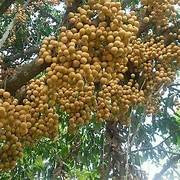Detannification of <i>Ananas comosus</i> Rinds Juice with Tnnase Immobilized on the Beads of <i>Chrysophyllum albidum</i> Seeds
http://www.doi.org/10.26538/tjpps/v3i1.4
Keywords:
Rhodotorulla mucilaginosa, Tannin, Ananas comosus, tannase, Chrysophyllum albidumAbstract
Billion tons of agro wastes that constitute hazard to the environment are generated annually all over the world. How to curb this menace remains a major challenge in the field of biotechnology. In this study, a novel immobilization material for microbial tannase was developed from Chrysophyllum albidum seeds. Optimization studies for effective performance of the novel immobilization material were conducted. The characterized immobilized tannase was explored for the detannification of tannin present in Ananas comosus rinds juice. Activities of free and immobilized tannase from R. mucilaginosa CBS 316 were 724.49 and 497.77 U/g/min respectively. Optimal temperature and pH for tannase activity were 35ºC and 7 respectively. Optimum tannase load, bead size and bead number for immobilized tannase were 35%, 8mm and 20 respectively. Immobilized tannase was reusable for up to 3 times. MgSO4, KCl, and ZnSO4 enhanced tannase activity while PbCl2, MgCl, BaCl2 and EDTA inhibited the activity of tannase. Tannin content of the three varieties of Ananas comosus rinds juice from Bene, Cotonou and Local source were drastically reduced from 17.8, 16.3 and 5.9 mg/100g to 3.9, 2.9 and 1.8 mg/100g respectively when treated with immobilized tannase. This study established the detannification of Ananas comosus rinds juice with microbial tannase immobilized on the novel beads of Chrysophyllum albidum seeds.
References
Arsyada IF, Rianti D, Munadziroh E. Antibacterial activity of mixed pineapple peel (Ananas comosus) extract and calcium hydroxide paste against Enterococcus faecalis. Dent Journa., 2018; 51:20-24.
Amballa C, Anbalagan M. Expression, purification and immobilization of tannase from Staphylococcus lugdunensis MTCC 3614 . AMB Expr. 2016; 6:89.
Miura A, Giatti C, De Souza M, Bracht A, Kimiko M, Cristine A, Oliveira RF, Peralta RM. Production of tannase and gallic acid by Aspergillus tamarii in submerged and solid state cultures. Afr J Biochem Res. 2013; 7:197–202.
Abril FLV, Rodr´ıguez-Dur´an JR, Juan C, Contreras RR, Crist´obal NA. Catalytical Properties of Free and Immobilized Aspergillus niger tannase. Enz Res. 2011; 6:768183.
Banjo T, Kareem S, Popoola T, Akinloye O. Biosynthesis of ascorbic acid by Aspergillus flavus and Aspergillus tamarii immobilized in Afzelia africana matrix. FABJ. 2018; 6(1): 39–52.
Bradford MM. “A rapid and sensitive method for the quantitation of microgram quantities of protein utilizing the principle of protein dye binding. Anal Biochem. 1979; 72(2): 248–254.
Sharma S, Bhat TK, Dawra RK. A spectrophotometric method for assay of tannase using rhodanine. Anal Biochem. 2000; 279:85–89.
Battestin V, Macedo GA. Effects of temperature, pH and additives on the activity of tannase produced by Paecilomyces variotii. EJB. 2007; 10(2):191–199.
Sharma S, Ghoshal C, Arora A, Samar W, Nain L, Paul D. 2021. Strain Improvement of ative Saccharomyces cerevisiae LN ITCC 8246 strain through protoplast fusion to enhance its xylose uptake. Appl Biochem Biotechnol. 2021; 193(8):2455-2469.
Mueller-Harvey I. Analysis of condensed tannins: a review. AFST. 2001; 91: (1-2) 21-40.
Jiménez N, Esteban-Torres M, Mancheño JM, de Las Rivas B, Muñoz R. Tannin degradation by a novel tannase enzyme present in some Lactobacillus plantarum strains. Appl Environ Microbiol 2014; 80:2991–2997.
Famotemi AC Lawal AK, Dike EN, Olatope SOA, Shittu KA, Itoandon EE, Kehinde MO, Orji FA, Elemo GN. Production of pectinase from strains of Aspergillus niger using corn pomace by solid state fermentation. Int. J. Adv. Res. Biol. Sci. 2015; 2(5): 93–99.
Selwal MK, Selwal KK. High-level tannase production by Penicillium atramentosum KM using agro residues under submerged fermentation. Ann. Microbiol. 2012; 62: 139-148.
Darah I, Ong CB, Jain K, Lim SH. Enhancement of tannase production on submerged fermentation by red yeast Rhodotorula glutinis DB2. J Pure Appl Microbiol. 2013; 7(3): 1525–1534.
Chong-Boon O, Darah I, Mohd JN, Mohd K. The Tannase from red yeast Rhodotorula glutinis: purification and characterization. Biocat and Biotrans. 2022; DOI: 10.1080/10242422.2022.2136523.
Chávez-González M, Rodríguez-Durán LV, Balagurusamy N, Prado-Barragán A, Rodríguez R, Contreras JC, Aguilar CN. Biotechnological advances and challenges of tannase: an overview. FBT. 2012; 5:445–459.
Mahmoud AE, Fathy SA, Rashad MM, Ezz MK, Mohammed AT. Purification and characterization of a novel tannase produced by Kluyveromyces marxianus using olive pomace as solid support, and its promising role in gallicacid production. Int. J. Biol. Macromol. 2018; 107: 2342-2350.
Aharwar A, Parihar DK. Talaromyces verruculosus tannase production, characterization and application in fruit juices detannification. Biocatal. Agric. Biotechnol. 2019; 18: 101-014.
Gonçalves HB, Riul AJ, Terenzi HF, Jorge JA, Guimarães LHS. Extracellular tannase from Emericella nidulans showing hypertolerance to temperature and organic solvents. J Mol Catal B Enzym. 2011; 71:29–35.
Costa AM, Souza CGM, Bracht A, Kadowaki MK, Souza AC, Oliveira RF, Peralta RM. Production of tannase and gallic acid by Aspergillus tamarii in submerged and solid state cultures. Afr. J. Biochem. Res. 2013; 7:197-202.
Sheldon RA, Van Pelt S. Enzyme immobilization in biocatalysis: Why, what and how? Chem. Soc. Rev. 2013; 42:6223–6235.
Bagga J, Pramanik SK, Pandey V. Production and purification of tannase from Aspergillus aculeatus using plant derived raw tannin. Int. J. Sci. Eng. Technol. 2015; 4(2): 50-55.
Kareem SO, Oladipupo IO, Omemu AM, Babajide JM. Production of citric acid by Aspergillus niger immobilized in Detarium microcarpum matrix. Mal. J. Microbiol. 2013; 9(2): 161-165.
Gupta S, Bhattacharya A, Murthy CN. Tune to immobilize lipases on polymer membranes: Techniques, factors and prospects. BAB. 2013; 2:171–190.
Cavalcanti RMF, Maestrello CC, Guimarães LHS. Immobilization of the Tannase From Aspergillus fumigatus CAS21: Screening the Best Derivative for the Treatment of Tannery Effluent Using a Packed Bed Reactor. Front. Bioeng. Biotechnol. 2021; 9:754061.

Published
How to Cite
Issue
Section
License
Copyright (c) 2024 Tropical Journal of Phytochemistry and Pharmaceutical Sciences

This work is licensed under a Creative Commons Attribution-NonCommercial 4.0 International License.
















